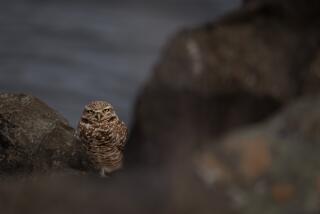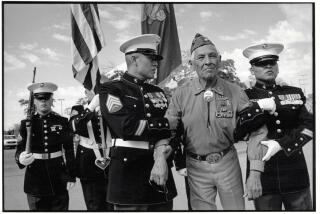Eagle Repository Helps Tribes Keep Beliefs Alive
- Share via
COMMERCE CITY, Colo. — Dennis Wiist may not have the most unusual job in the federal government, but he’s probably in the running.
Wiist is a “wildlife repository specialist” with the U.S. Fish and Wildlife Service, and he spends his days among frozen carcasses of bald and golden eagles at his office in a converted warehouse on the grounds of the Rocky Mountain Arsenal National Wildlife Refuge outside Denver.
Actually, though Wiist does spend a fair amount of time handling dead eagles while dressed in a protective suit and gloves in his lab at the Fish and Wildlife Service’s National Eagle Repository, what he really does for a living is attend to the spiritual and ceremonial needs of thousands of Native Americans for whom the federally protected eagles play a hugely important traditional role.
For a little more than two decades, the eagle repository has served as a kind of dead-eagle broker--taking in birds killed by power lines, collisions with autos, lead poisoning and natural causes, and distributing them to Native Americans who use the feathers and other parts in traditional regalia and religious ceremonies.
Because the birds are protected by the Bald Eagle Protection Act, the repository is the only place that Native Americans can legally obtain them once they receive a federal permit and demonstrate they are enrolled in a federally recognized tribe and will use the eagle for religious purposes. There is no fee for the eagles.
John Hornbrook, a member of the Choctaw nation of Oklahoma who works as an elementary school principal in Evansville, Ind., said receiving an eagle earlier this year represented “the completion of a process” that allows him to connect with his spiritual heritage.
“The eagle is the spirit messenger,” said Hornbrook. “It flies completely out of sight with all the majesty and grace that it has. Our ancestors believed for eons that it carries our prayers all the way to heaven.”
Hornbrook said he frequently uses the feathers and other parts from the mature bald eagle he received from the repository in traditional ceremonies. The head and one foot are mounted on his prayer stick. The feathers are mounted on his prayer pipe and a ceremonial staff that dates from the massacre of Wounded Knee.
When he smokes his prayer pipe, says Hornbrook, “the eagle carries my prayer to the creator and I am connecting with the eagle who is the spirit messenger.”
Though the repository has been providing eagles since the 1970s, it has never caught up with demand. If a member of a federally recognized Indian tribe requests an eagle today, he is likely to have to wait as long as four years before receiving one, even though Wiist is getting eagle carcasses at the rate of about 1,000 a year.
Wiist concedes that the long waiting list occasionally breeds frustration, but he is that rare government bureaucrat with a happy customer base.
“It does take a long time because there are far more people who want an eagle than eagles that we receive,” says Wiist, who likes nothing better than calling up a Native American who has been on the waiting list for several years but whose eagle has finally come in. “We make some of them mad, but plenty of them happy too.”
Recently, for example, Wiist received an emergency request forwarded from the family of a Cayuga Indian in Georgia who was dying of cancer and whose last wish was to receive some eagle feathers so his soul could, according to Cayuga religious belief, be released and soar in heaven. A half-dozen feathers were express-mailed and arrived in Georgia the day before the man died.
“I feel like I’m doing something really important,” says Wiist. “By helping to protect the religious freedom rights of Native Americans, I’m helping to protect the religious freedom rights of everyone.”
Trained in college as a business major, Wiist has no formal background in wildlife biology but has extensive on-the-job training. Pulling several plastic bags containing bald and golden eagle carcasses from his walk-in freezer, Wiist shows a visitor the telltale signs of lead poisoning on one raptor, and the explosive effects of a high-tension wire on another.
“It’s discouraging to see how many badly damaged eagles come through here,” says Wiist, who will carefully salvage even a few intact feathers from a ravaged carcass so he has a ready supply of spares to send along with whole eagles that may be missing a few tail or primary wing feathers. Or to send to those Indian schools that have a tradition of giving one eagle feather to each graduate.
Wiist and his supervisor, Bernadette Hilbourn, are engaged in a continual campaign to educate their colleagues in the Fish and Wildlife Service, state wildlife agencies and bird-rehabilitation centers about their program so dead eagles don’t go to waste. They’re making progress, but they are still a long way from matching supply and demand.
“They’re becoming more and more knowledgeable about the program,” says Hilbourn, “but it’s a never-ending cycle.”
More to Read
Sign up for Essential California
The most important California stories and recommendations in your inbox every morning.
You may occasionally receive promotional content from the Los Angeles Times.










